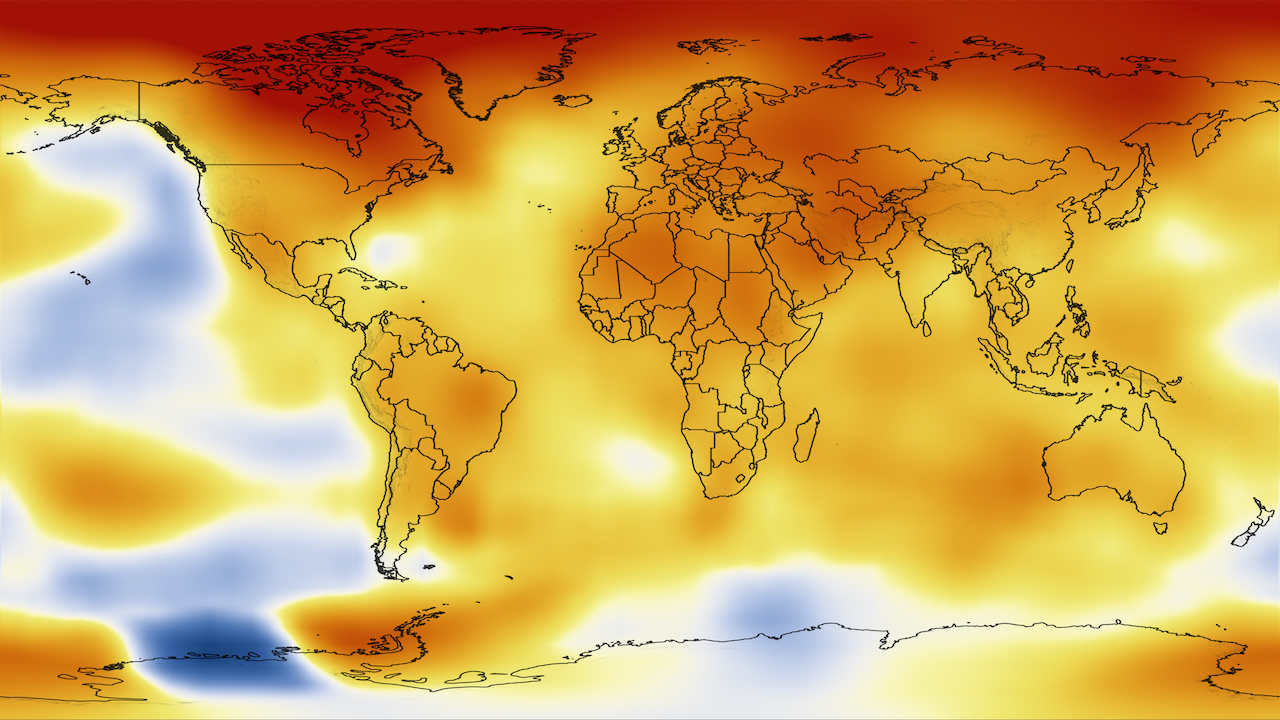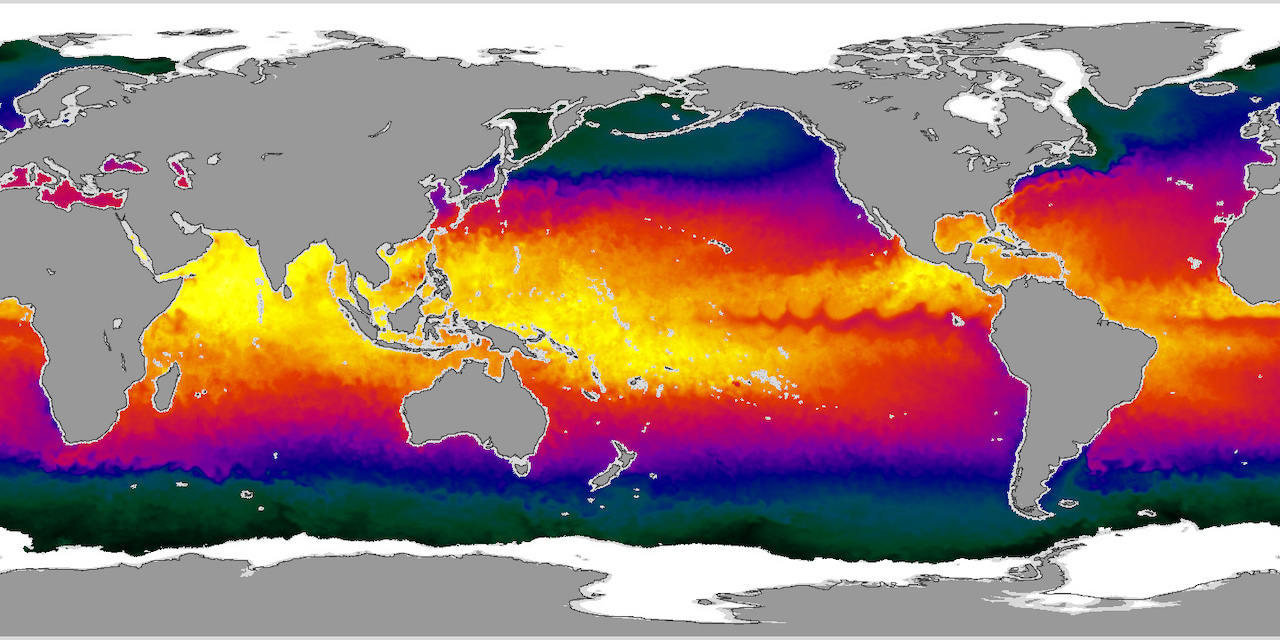What is the average temperature on Earth?
It's a hot topic.

The average surface temperature on Earth is approximately 59 degrees Fahrenheit (15 degrees Celsius), according to NASA.
However, the planet's average temperature is rising. The 10 warmest years across the entirety of recorded human history have all occurred since 2010. NASA recently announced that 2023 was Earth's hottest summer on record (since at least 1880). The record-breaking temperatures are the result of human-driven climate change, spurred on by the recurring climate pattern known as El Niño.
Based on NOAA’s temperature data, 2020 was the second warmest year ever recorded, just behind 2016. In the 21st century, the average yearly temperature on Earth has been more than 2 degrees F (more than 1 degree C) higher than recorded pre-industrial temperatures.
Earth is the only planet we know of that can support life. The planet has two major advantages that keep it habitable: its distance from the sun, and its protective atmosphere.
Earth lies in a "Goldilocks zone" that is not too far from the sun, but not too close either. The distance from Earth to the sun is one of the most important factors in making Earth habitable. Much closer, and seas would boil: temperatures on Venus, the next closest planet to the sun, reach more than 880 degrees Fahrenheit (471 degrees Celsius), Space.com previously reported. While the closest planet to the sun, Mercury, doesn’t trap heat like Venus, its surface can still top 840 degrees Fahrenheit (450 degrees Celsius). Meanwhile, one planet farther from the sun, the average temperature on Mars is minus 80 degrees F (minus 60 degrees C).
In addition, Earth's atmosphere plays a vital role in regulating the temperature. The atmosphere provides a blanket of gases that not only protects us from excessive heat and harmful radiation from the sun, but also traps heat rising from the Earth's interior. Over the past few hundred years, the planet’s atmosphere has been altered by human industrialization, changing the way it traps and releases heat.
Measuring global temperature
To estimate the global temperature, researchers measure air temperatures on land and at sea at thousands of observation stations around the world, day in and day out. Then, they add all those measurements up and divide the result by the number of observations taken — that gets them an average air temperature for the whole globe.

At any given time on Earth, the temperatures at the hottest place and coldest place on the planet are probably almost 100 degrees F (55 degrees C) apart, according to NOAA, so an average temperature for the whole planet doesn’t do much to tell you what the weather is like outside. After all, right now it’s night somewhere and daytime somewhere else, and while it’s winter in the Northern Hemisphere, it’s summer in the Southern Hemisphere (and vice versa). But averaging temperatures around the whole globe does tell us a lot about the energy that circulates around the planet over longer periods of time, and can help researchers understand trends in climate change.
It’s difficult to get good temperature estimates around the whole planet. According to NASA Climate, global temperature data comes from thousands of observation stations, but in some regions, such as unoccupied deserts and mountaintops, stations are more difficult to set up and maintain. Meanwhile, even researchers analyzing the same data can use different methods for calculating the global average — although all show an upward trend in average temperature over the past few decades.
For example, NOAA reported in a press release that 2020 was the second-warmest year on record, in agreement with the United Kingdom Met Office, while measurements from NASA and the European Union’s Earth observation agency Copernicus ranked it as tied with 2016 for the top spot.
Temperatures are less useful for climate researchers than temperature anomalies, so most temperature reports use temperature anomalies: the difference between current temperature and a historical average.

NASA's Goddard Institute for Space Studies (GISS) assumes that temperature anomalies are about the same up to about 1,200 kilometers from a station. That method means they can estimate temperatures using a smaller number of stations, especially in the polar regions. NOAA, on the other hand, uses different areas, and produces a more conservative estimate.
NOAA tracks anomalies relative to temperatures between 1901 and 2000. According to NOAA's data, average anomalies calculated for 2020 were 1.76 degrees F (0.98 degrees C) higher than the average temperatures for all the years in the 20th century.
GISS measures the change in global surface temperatures relative to average temperatures from 1951 to 1980. According to GISS data, global average temperatures in 2020 were 1.84 degrees F (1.02 degrees C) above the 1951-1980 historical mean.
What are the most extreme temperatures on Earth?
According to the World Meteorological Organization, the coldest temperature measured on Earth was at Vostok Station in Antarctica, where it reached minus 128.6 degrees F (minus 89.2 degrees C) on July 21, 1983. The coldest inhabited place is Oymyakon, Russia, a small village in Siberia, where it dips down to an average of minus 49 F (minus 45 degrees C) and once hit a low of minus 96.16 F (minus 71 degrees C).

El Azizia, Libya, held the top hot spot for 90 years. Temperatures allegedly climbed to 136.4 degrees F (58 degrees C) on Sept. 13, 1922. But the World Meteorological Organization stripped the town southwest of Tripoli of that distinction in 2012, according to a press release. A committee of climate experts from nine countries concluded that the temperature had been documented in error by an inexperienced observer.
The hottest temperature currently recognized was recorded at Greenland Ranch (Furnace Creek) in Death Valley, Calif., where it reached 134 F (56.7 C) on July 10, 1913. But even that distinction depends on what is being measured. Death Valley's record is for the highest air temperature. A higher surface temperature of 159.3 F (70.7 C) was recorded by a Landsat satellite in 2005 in the Lut Desert in Iran, according to a 2021 paper published in the journal Bulletin of the American Meteorological Society. The paper suggests that the recorded temperature might even be an underestimate.
Temperature extremes by continent
This chart shows the temperature records for each continent — the highest and lowest temperatures recorded in North America, South America, Europe, Asia, Africa and Antarctica. These records are kept by the World Meteorological Association, which divides continents using its own regions. Those divisions include Greenland and some of the Middle East as part of Europe, for example, but other countries in the Middle East are considered part of Asia.
| Continent | Temperature | Date | Location |
| North America | High: 134 F (56.7 C) | July 10, 1913 | Furnace Creek Ranch, Death Valley, Calif. |
| Low: -81.4 F (-63 C) | Feb. 3, 1947 | Snag, Yukon Territory, Canada | |
| South America | High: 120 F (48.9 C) | Dec. 11, 1905 | Rivadavia, Argentina |
| Low: -27 F (-32.8 C) | June 1, 1907 | Sarmiento, Argentina | |
| Europe | High: 129.2 F (54 C) | June 21, 1942 | Tirat Tsvi (Tirat Zevi) Israel |
| Low: -93.3 F (-69.6 C) | Dec. 22, 1991 | Klinck, Greenland | |
| Asia | High: 129.0 F (53.9 C) | July 21, 2016 | Mitribah, Kuwait |
| Low: -90 F (-67.8 C) | 1) Feb. 5, 18922) Feb. 6, 1933 | 1) Verkhoyansk, Russia2) Oymyakon, Russia | |
| Africa | High: 131 F (55 C) | July 7, 1931 | Kebili, Tunisia |
| Low: -11 F (-23.9 C) | Feb. 11, 1935 | Ifrane, Morocco | |
| Australia/ Southwest Pacific | High: 123 F (50.7 C) | Jan. 2, 1960 | Oodnadatta, South Australia |
| Low: -14 F (-25.6 C) | July 17, 1903 | Ranfurly, New Zealand | |
| Antarctica | High: 67.6 F (19.8 C) | Jan. 30, 1982 | Signy Research Station, Antarctica |
| Low: -129 F (-89.2 C) | July 21, 1983 | Vostok Station, Antarctica |
How is the Earth’s temperature changing?

The National Oceanic and Atmospheric Administration (NOAA) reported average surface temperatures on Earth rose, on average, 1.71 degrees Fahrenheit (0.95 degrees Celsius) between 1880 and 2016. The average rise has been accelerating in recent years, and the Earth’s atmosphere now traps twice as much heat as it did in 2005 due to human industrialization and fossil fuel consumption.
In 2015, 159 nations ratified the Paris Agreement, a commitment to change behavior and consumption to try to halt the warming at 2.7 degrees F (1.5 degrees C) above Earth's average temperature before the Industrial Age. Given industry and transportation reliance on fossil fuels, many studies suggest that agreement will be difficult to keep to.
In fact, we have likely already committed the planet to warming past the Paris Agreement target, Space.com previously reported.
Global warming is now included in larger discussions of “climate change.” The planet’s average temperature is rising — some areas are seeing even faster warming temperatures, like Europe and the Arctic — but as the temperature rises and the planet traps more heat, wrote NASA, that process also prompts sea level rise, glacier and ice sheet melting, and even changes in growing seasons for wildlife and crops. Climate change and global warming make hurricanes stronger, and can prompt drought and heat waves in some places while worsening floods in others.
A rise of a few degrees in temperature may not seem like much, but according to NASA, during the last ice age when northeastern North America was covered by more than 3,000 feet of ice, the global average temperature was only 5 to 9 degrees cooler than it is today.
Additional resources
If you want to know more about Earth at different average temperatures through its history, check out this feature from News from Science about the Smithsonian Museum of Natural History’s updated fossil hall — or visit the hall yourself!
For books on Earth’s temperature, climate change and the future of life on Earth, try Mary Robinson’s 2018 book Climate Justice, or All We Can Save, a 2020 collection of essays edited by Ayana Elizabeth Johnson and Katharine K. Wilkinson.
Bibliography
"2020 Was Earth’s 2nd-Hottest Year, Just behind 2016." National Oceanic and Atmospheric Administration, January 14, 2021. https://www.noaa.gov/news/2020-was-earth-s-2nd-hottest-year-just-behind-2016.
Earth Science Communications Team. "The Effects of Climate Change." Climate Change: Vital Signs of the Planet. NASA’s Jet Propulsion Laboratory, January 26, 2022. https://climate.nasa.gov/effects.
Climate Change: Vital Signs of the Planet. "FAQ: Global Warming vs Climate Change?" Accessed January 27, 2022. https://climate.nasa.gov/faq/12/whats-the-difference-between-climate-change-and-global-warming.
Rebecca Lindsey and Luann Dahlman. "Climate Change: Global Temperature." Climate.gov. NOAA, August 12, 2021. https://www.climate.gov/news-features/understanding-climate/climate-change-global-temperature.
U.S. Global Change Research Program, D.J. Wuebbles, D.W. Fahey, K.A. Hibbard, D.J. Dokken, B.C. Stewart, and T.K. Maycock, eds. "Climate Science Special Report: Fourth National Climate Assessment, Volume I." U.S. Global Change Research Program, 2017. https://doi.org/10.7930/J0J964J6.
"WMO: Ninety-Year-Old World Temperature Record in El Azizia (Libya) Is Invalid," September 13, 2012. https://public.wmo.int/en/media/news/wmo-ninety-year-old-world-temperature-record-el-azizia-libya-invalid.
"World Meteorological Organization’s World Weather & Climate Extremes Archive." Arizona State University. Accessed January 26, 2022. https://wmo.asu.edu/content/world-meteorological-organization-global-weather-climate-extremes-archive.
Zhao, Yunxia, Hamid Norouzi, Marzi Azarderakhsh, and Amir AghaKouchak. "Global Patterns of Hottest, Coldest, and Extreme Diurnal Variability on Earth." Bulletin of the American Meteorological Society 102, no. 9 (September 1, 2021): E1672–81. https://doi.org/10.1175/BAMS-D-20-0325.1.
Join our Space Forums to keep talking space on the latest missions, night sky and more! And if you have a news tip, correction or comment, let us know at: community@space.com.
Get the Space.com Newsletter
Breaking space news, the latest updates on rocket launches, skywatching events and more!

- Daisy DobrijevicReference Editor










